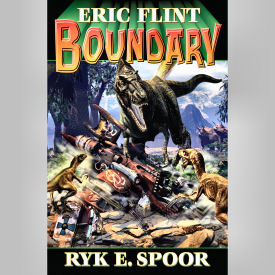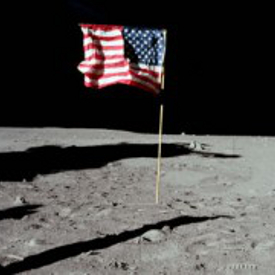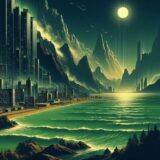
This week I’ve been pretty wiped out, physically, from a bit of anemia—my doctor has me on iron pills—so I’m going to cheat a bit and rewrite an older column that I hope will be somewhat new to those of you who weren’t reading these three years ago. But before I do, I have to tell you of a terrific offer: Amazon.com and Amazon.ca both have the Kindle version of this terrific book at left—the first one in a series of (so far) 5—for free right now! (At least on Thursday, March 23, as this column is being written/edited.) I don’t want to wax too enthusiastic about the book or the series, as I’m planning to review the whole thing after next payday, when I can afford the rest of the books (interestingly enough, the hardcovers—including shipping—are sometimes cheaper than the ebooks!); I don’t want to review books by living authors who haven’t been “paid,” so to speak. I have no compunction about public domain SF—I’ll happily download and review it—but feel that living authors might even depend on that income, no matter how minor their share. The cover is by Kurt Miller, according to author Ryk E. Spoor’s website. I’ve been an Eric Flint fan for a while—met him briefly a year or two ago at a con—and picked this one up. How can you not like a free SF book by a pair of very competent authors?

As I mentioned in a previous column, nametags are a wonderful way to remember conventions years after they’ve passed. The first Worldcon I attended, as you can see from the picture, was in 1976 in Kansas City, Missouri. The writer Guest of Honor was Robert A. Heinlein, and the artist GOH was George Barr, who did the program book dustjacket and the logo which was used on the nametag shown here. (The reason there’s a bull wearing a space helmet is, if you didn’t know, that Kansas City is famous for its steak; since cowboy days it’s been a nexus for cattle and cattlemen. There are two Kansas Cities—again, in case you didn’t know: one’s in Missouri, and one’s right across the river in Kansas, so the locals, as far as I know, say “KCMO” to make it clear which KC they’re talking about. I had a Kansas City steak with a party of con-goers, and I can tell you the Kansas City strip is better in KCMO than any I’ve had anywhere else!)
Anyway, the con was wonderful; I went with my late friend Jon Gustafson, who was Art Editor on our fanzine, New Venture, and we had a terrific time hobnobbing with the great, near-great and not-so-great. The Art GOH, George Barr, was a friend, so we got invited to the private GOH party he threw; we reconnected with old friend Kelly Freas, who was there at the behest of Roger Elwood’s Laser Books—Kelly did all the covers for Laser. I also met lots of people I hadn’t met before, like Glenn Lord, the executor of Robert E. Howard’s literary estate (I’m a big REH fan, and have the original Gnome Press hardcovers—ex-library, unfortunately, but what can you do?—in my collection), as well as Donald Grant, who was publishing a lot of REH in marvelous limited-edition illustrated hardcovers.

I also met Leigh Brackett, whose Eric John Stark books set in a Mars that never was are some of the greatest old SF ever written—and she was also a screenwriter, who wrote the screenplays to The Big Sleep and The Empire Strikes Back, among others. (At this point, George Lucas was four years in her future!) She was married to another great “Golden Age” science fiction writer, Edmond Hamilton. I touched base with Frank and Bev Herbert and Bev’s cousin, Martha, whose last nam escapes me, and took pictures of them with Heinlein’s old schoolfriend, Sally Rand, who was famous for her fan dancing in the ‘30s and ‘40s. Sally was about four and a half feet tall, so unfortunately, my old Argus camera, which had an optical viewfinder, took some terrific pictures of the top of her wig. I made the mistake of asking Sally if she was an “ecdysiast”—she drew herself up to her full height (as said, about four and a half feet) and said, stiffly, “Young man, Gypsy Rose Lee was an ecdysiast. I am a dancer!” I apologized at once and the awkward moment passed. That was also where I first met Marvel comic people Len Wein and Marv Wolfman, I believe (although that could have been Denvention). It was everything a first Worldcon should be!
My second Worldcon was in Denver, in 1981—that was Denvention II, as Denver had hosted the third Worldcon back in 1941, so this was the fortieth anniversary. I came to this one with my then-wife, Mary, who had sat at home while I gallivanted around the country with Jon Gustafson; this time, she was going to go do interesting stuff while I attended the convention. Denvention II was also a fun convention; Jon and I (yes, he came, but not with me!) spent much of our con time with a few new friends—Ron Salomon of the New York area and his mom, Doris; and Anders Bellis and another Swedish fan named Roger Sjolberg (Bellis and Ron are still good friends; I’ve recently reconnected with them on Facebook. I love teh interwebz!)

I also got to “do” the convention as a Press Person—here’s my press pass, which got me into several “closed” events, like the Hugo Awards; even though they were “standing room only,” I got in as a Press representative, as I was writing my fan column for the print version of Amazing at that time. Speaking of the Hugos, Jon and I got to sit in the “nominees” section at the Hugos in Kansas City, as Richard E. Geis, who published Science Fiction Review, had been nominated both for SFR, and as Best Fan Writer, and had asked Jon to pick up his Hugo should he win. Geis lost the Best Fanzine award to LOCUS (then published by Charles and Dena Brown), but won Best Fan Writer Hugo, and Jon got to go on stage—at his very first WorldCon!—and accept for Geis, who never left Portland if he could help it. (Geis’s health was not very good, as I recall.)

If you don’t attend many big cons, you might not know what that strip of fabric with a koala sticker on it is, hanging from my Denvention badge (Figure 4). Often, a convention bidding for a worldcon (or a large regional con such as Westercon) will have promo items to give away; this one was for the Australian Worldcon bid in 1983 or 1984. They won the 1985 bid and held the Worldcon in Melbourne (where my mother was from!).
At Denvention I connected with other friends, like Steve Schlich and the late Jim Young of Minneapolis, and again had a wonderful time! I also met Forry Ackerman (not for the first time; I had been to his house in LA when I was in the Navy) and a few Big Name Fans I knew only by reputation, like Walt Liebscher, Margie Ellers, and others. And this time I was not a WorldCon neo, and knew how to find the best parties and make new friends. Incidentally—if you go to a convention and don’t know anyone, it’s a very good idea to just go up and meet people. I’ve met some of the nicest people—many of whom are still very good friends—at conventions just by introducing myself! Very few of them carry Tasers or pepper spray, and I can count on the fingers of one hand the number of times I’ve been assaulted just for trying to meet someone! (That’s a joke, by the way. Introducing yourself to someone you don’t know at a convention is a terrific way to meet new people!)
As you become known in fandom, you will often be given the chance to attend a convention as a guest—usually as a fan GOH; one of the places I’ve been invited to, which is, I think relevant because they’ve won the WorldCon in 2015, is Spokane, in eastern Washington. (They held the 2015 WorldCon, called Sasquan, too. Unfortunately, I was unable to attend.)

Spokane at the time was mostly noticeable for having held a World’s Fair in 1974; it was the first “environmentally-themed” world’s fair. (One of the things I remember about Expo ’74 was, in the Canadian Pavilion, while nobody else was around, sneaking behind the plexiglas® shield and rubbing the actual Albertosaurus skull they had there! It was my first, and so far only, chance to touch an actual dinosaur.) Other than that, many people haven’t really heard of the city, though it’s a pretty nice place. Author C.J. Cherryh moved there from Oklahoma City, you know, which must be some kind of recognition. Anyway, I was Fan GOH at Spokon in 1984, and David Eddings, author of The Belgariad Cycle, was pro GOH. The convention was held in the Hotel Davenport, which is a beautiful, old hotel that had been completely refurbished. Interestingly enough, sometime around Expo time, when Jon Gustafson and I had lunch with Frank Herbert at the Old Mill (the restaurant’s name was “Clinkerdagger, Bickerstaff, and Petts”), Frank told us that the Expo people had paid a very large sum to a famous American poet to write a poem for Expo ’74. They had gotten a poem they couldn’t use—the poet had rhymed every verse with “spo-kayne’” and the actual city name is pronounced “Spo-can’”!)

The Spokon nametag was done by local artist Randy Mohr, who has since moved. The con committee also gave us nifty metal nametags—you can see mine here. Frankly, I remember nothing about the convention except that the con committee worked very hard to make it a wonderful convention, and I enjoyed the heck out of myself. Which is what a con’s for, right? Unfortunately, at that time I was going through marital problems, and I think my mind has blanked that part of my past completely, or nearly so. The next year I moved to Canada and got married again! And I’ve been here in Canada for 32 years now.
Again, I welcome comments, good or bad, on my column. If you want to post them online you can register—if you haven’t already—and comment here on the Amazing Stories website, or else you can comment on Facebook. I publish links in at least 3 Facebook groups. See you next week!











Recent Comments